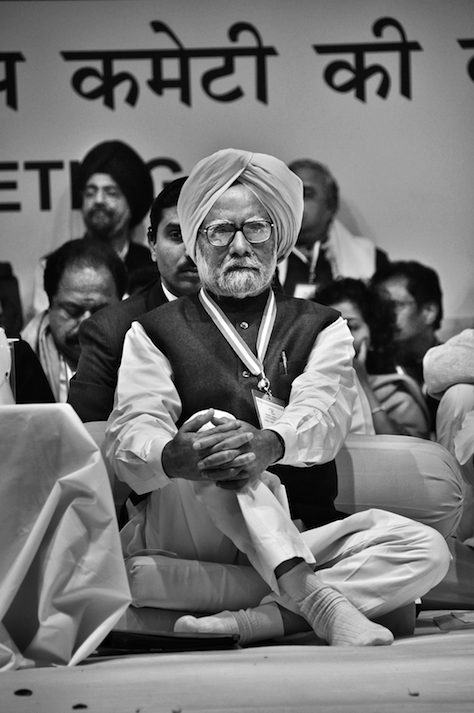From Scroll.in comes this piercing photo of former Indian prime minister Manmohan Singh in January, four months before the landslide election that delivered to Singh’s ruling Indian National Congress (Congress, भारतीय राष्ट्रीय कांग्रेस) its worst defeat in Indian history.![]()
Raghu Rai, a photographer and journalist, captured images of both Singh and India’s current prime minister Narendra Modi for his new book, The Tale of Two: An Outgoing and An Incoming Prime Minister.
The photos of both candidates are compelling, but the shots of Singh are particularly so, coming after a decade as prime minister that most Indians (and non-Indians) consider disappointing.
An economist by training, Singh made his international reputation as the finance minister in the government of P. V. Narasimha Rao between 1991 and 1996, spearheading the most thoroughgoing set of economic liberalization reforms in India’s post-independence history.
When Sonia Gandhi, the Italian-born widow of former prime minister Rajiv Gandhi and daughter-in-law of former prime minister Indira Gandhi, demurred from taking the premiership after Congress won a surprise victory in the 2004 parliamentary elections, she turned to Singh instead, boosting hopes that India might enact further reforms, especially with respect to liberalizing foreign development. It also gave India its first leader from the Sikh community.
But those economic reforms never happened, which voters didn’t seem to mind in Congress’s first term. After all, the economy was still growing at breakneck speed and Indian voters hadn’t become acquainted with the dozens of scandals (e.g., Coalgate, the 2g spectrum scandal) that would come to define Congress’s second term, which Singh and Gandhi won easily enough in 2009 under the steam of India’s stellar growth.
It took a while, even after India’s economy sputtered, for Singh to receive the brunt of the blame. Despite the breadth of unacceptable graft within government, Singh himself was always above reproach, a pillar of integrity.
In his first term, Singh muscled through the nuclear deal with US president George W. Bush, overriding Sonia’s initial concerns. But by the end of his second term, it was clear that though Singh was in office, it was Sonia who was truly in power. On the eve of the 2014 elections, Singh’s former media adviser, Sanjaya Baru, published The Accidental Prime Minister: The Making and Unmaking of Mamohan Singh, a withering account of the Singh-Gandhi relationship.
Modi and his colleagues in the conservative, Hindu nationalist Bharatiya Janata Party (the BJP, भारतीय जनता पार्टी) mocked shortly afterward that the Modi would be no ‘accidental’ prime minister.
Ironically, Singh could claim that the 2009 victory was a mandate for Singh’s leadership, even though he made the critical error not to run for a seat directly in the Lok Sabha (लोक सभा). But as Baru and so many others noted, Singh, for whatever reason, never directly challenged Sonia Gandhi to take a more assertive role over Indian governance after that election.
As Congress’s election campaign faltered this spring, Singh increasingly took much of the blame for its problems. It’s not the first time that a Gandhi has tried to shift blame to a non-Gandhi prime minister. Scorned as Sonia’s puppet, it’s easy to forget that Singh is still the longest-serving prime minister in India’s history outside of the Nehru-Gandhi family. Or that, for his failures as prime minister, the Rao-Singh reforms of two decades ago provide a blueprint for the Modi government’s expected reform efforts. Ironically, Modi can arguably claim that his sweeping mandate is to enact the kind of reforms that everyone once expected Singh would pursue as prime minister.
Always a taciturn prime minister, Singh became increasingly mute in the face of growing criticism — that he couldn’t stand up to Sonia, that he couldn’t enact anything but the most feeble eleventh-hour reforms to liberalize India’s retail sector, that his government’s slow response on rape laws and criminal reform leaves too many Indian women in jeopardy.
History may yet treat Singh more kindly that the Indian electorate did last month, but Rai’s photos capture perfectly the sense of isolation and impotence that Singh surely felt at the end of a frustrating decade.
